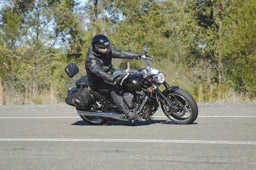
If your wrists, elbows and shoulders are rigid (“stiff-arm”) your body weight will force steering inputs to the bars when going over bumps in curves. This may be disconcerting and can make you tense and struggle for control. It’s you, fighting steering inputs of your own. The front end will always move about a little over bumps, get used to it and don’t strangle it. The bike will go around the corner, as long as you don’t do something to foul it up. All you have to do is steer it correctly.
If you have been riding for hours and are just tired you may find yourself leaning on the ‘bars and with stiff joints. This is a serious problem, as you need to be flexible and supple when entering curves after a long transport section.
Your physical fitness must be factored into your risk management. Weekend warriors take note.
Smooth through curves is a combination of a lot of little things.
It shows a rider has skill, understanding and judgement.
It has at its core, a PLAN for the corner, then a plan for the next one and while you are executing the first plan, you are making the next plan, from one tip-in point to the next and adding in all the other observations, factoring for likely and low-incidence, but deadly hazards (such as head-on crash on curve). You are risk managing from one curve to the next and using skills to make the transitions from curve to curve as seamless as your braking and acceleration. Your tyres are able to deliver their best for you, with no abrupt shocks at the contact patch.
When you are clear about what you want to do, follow the plan. Taking care of details is essential, otherwise, smoothness will elude you.
Smoothness is almost a religion to some riders. It is perfection at work, with the next corner more perfect than the one before.
It is harmony, it is heaven on earth and pure joy. It is not about being the fastest, it is about the sheer pleasure of riding well, with ample margins for safety and mental space to really enjoy the experience. Mind you, a smooth rider is quick and safe.
Those who lack smoothness have a crowded mind, without the spare mental space to use on safety or enjoyment. They are just working hard and wear themselves out with stress, becoming tired and a risk to themselves and others.
The right place on the road at all times. Seeking good sight lines, spotting and appropriately dealing with road surface imperfections with plenty of margin for the unexpected.
More in section on “Cornering Lines”
(meanwhile, get the RTA booklet “Braking Habits” and check out Page 9)
The tip-in point of any corner is near the point where you can see the most of the corner. This is where race-track and road are very different. On the road, the surface is not perfect and there are vehicles coming the other way, so you only have part of the road width to use. Also, there may be a slow moving mob of pushbikes or a clapped out farm truck or bouncing furry things around the blind curve, so never travel faster than you can see to react and stop in time.
Set your entry speed appropriately.
Set yourself up, so that you will only increase your speed FROM the tip-in point. This makes for smooth riding if your braking is good and your observations are good.
i.e. keep braking until your speed is as slow as the tip-in point requires, but allow space for the suspension to settle after coming off brakes and before tipping in.
Do your braking then tip in – it’s two separate actions.
Get yourself sorted on these things, then learn to ride downhill, where in-corner speed corrections and steering with a loaded up front end can complicate things.
Remember…
Slow in, stable, accurate and smooth through, fast out.
Fast in, you may not come out all.
Contact Info
Motor Cycle Council of NSW
PO Box 517
Parramatta 2124
Ph: 1300 679 622 (1300 NSW MCC)
General Enquiries
Please direct enquiries to:
MCC Email
enquiries@mccofnsw.org.au
Site Menu